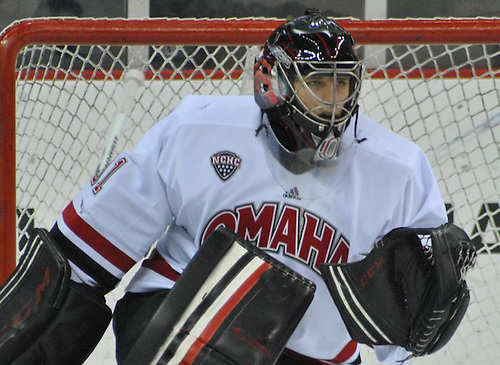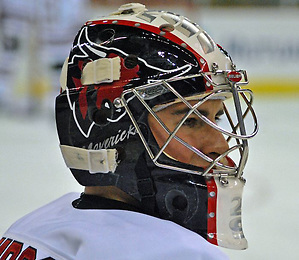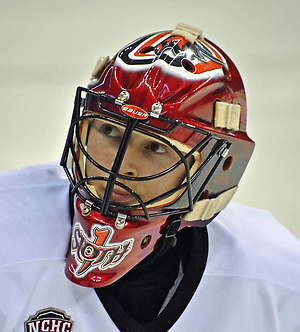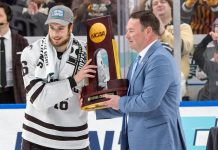
As soon as a goaltender commits to play at Nebraska-Omaha, still several months before he puts skate to CenturyLink Center ice for the first time, John Sparano gets straight to work.
The owner of Omaha-based company Helmethead Design, Sparano has painted Mavericks goaltenders’ masks since 2010 and he also works with the Omaha Lancers of the USHL. He’s been painting masks since 2006, and he now has the process down to a pretty exact science.
It’s not all down to just him, though. The potential for customization is what drives the industry he works in, and Sparano gives a lot of credit to the goaltenders he works with who literally wear his artwork season after season.
“I would say 95 percent of the time it’s more a 30-70 split,” Sparano said in terms of the ratio between what he offers in consultations with goaltenders and what they contribute at that stage.
“They give me a rough idea of what they want: ‘A logo here on the mask, my number here.’ They really don’t have things set in stone in their minds. I show them my ideas and we build off of that.
“The teams I work with stress that they want the masks to be team-oriented, so the player has a limited theme to work with, so that’s why it’s more on me to come up with the ideas and fit [the players’ and teams’] wants into it.”
As for how the collaborative part of the process works, Sparano said it’s largely the same every time.
“The process is the same for all clients. I meet them, they tell me what they want on their mask, I go and come up with some ideas,” Sparano said. “I then send my ideas to them. Most times they come back and have some changes or come up with something else they want on it.
“Sometimes I hit the nail on the head the first time and life is good. So we bounce back and forth a few times with ideas and changes until we get it right, then we start painting.”
This year’s models
For Nebraska-Omaha freshman netminders Kirk Thompson and Reed Peters, this season is their first playing using painted masks, and they and Sparano began bouncing ideas off one another almost immediately after the athletes became Mavericks players.

“After I committed to UNO, I got a call from [Sparano] pretty quickly, and I’d never gotten a mask painted before, so I didn’t really know the whole process,” Thompson said.
“He told me he had some ideas, and I actually talked to one of my friends back home, and he had some ideas as he’s a pretty creative guy. So [my friend] drew up a sketch, and I sent it over to John, and I pretty much said this was the basic idea of what I wanted done, and we went from there.”
What emerged as the final product is based on what Thompson called a western theme, with riveted marks down either side similar to those one might find on a cowboy boot.
UNO’s secondary bullhead logo also features on both sides, and the two sides — painted in UNO’s primary colors of red and black — are separated by a white bar down the front of the mask emblazoned with the word ‘Omaha’ and Thompson’s sweater number.
Peters and Sparano ended up going with a somewhat less elaborate design than what’s found on Thompson’s mask.
For Peters’ mask, Sparano used only red as a base color and included an amalgamation of UNO’s primary and secondary logos on the top and two Omaha-area points of interest — the “Desert Dome” exhibit at Henry Doorly Zoo and the winding Bob Kerrey Pedestrian Bridge over the Missouri River — on either side.
On the bottom of the front side of Peters’ mask is a custom logo that combines both his sweater number and his, to put it mildly, unusual nickname.
“Most of the team calls me either Petey or Sloth or whatever else they want to call me,” Peters said. “But I got the Sloth nickname in high school and it just stuck.
“It started with high school hockey, and I’d always been kind of tall and lanky,” said the goaltender listed at 6-foot-3 and 180 pounds. “One guy one day said I looked like a sloth and everyone laughed, and that made it stick. It stayed that way with my high school team and I’ve been getting called that ever since.

“It usually carries on to other teams, so I’ll tell [new teammates] people have always called me Sloth, and they ask why and I tell them it’s because I look like one, or so everyone says, so it catches on. It’s a catchy name.”
An image of a sloth also features on the back of his mask inside a red maple leaf. Peters, from Morden, Manitoba, and Surrey, British Columbia, native Thompson both wear symbols on the backs of their masks representing their Canadian heritage.
Junior goaltender Ryan Massa, the Mavericks’ lone American goaltender, is onto his second mask painted by Sparano. For this season’s mask, he and Sparano got down to work just after UNO’s spring break, not long after the Mavericks’ 2012-13 season ended.
“We started working on the project right after spring break and started bouncing ideas off of each other in terms of what I was looking to do and what his ideas as an artist were, and we just kind of started brainstorming,” Massa said.
“Then it was down to eliminating certain ideas and figuring out what would look good on the mask, what wouldn’t, what color scheme we’d use, what color my pads were that I’d go with this year, and all that stuff.”
What they came up with incorporates things about Massa’s team as well as himself.
The Littleton, Colo., native’s mask for this season features a custom logo at the top of the mask featuring his sweater number as well as a depiction of the Rocky Mountains. On either side of the mask are an unofficial UNO bullhead logo and that of the first-year NCHC.
On the back, Massa went with a tribute to his grandfather, who passed away around the time that Massa and Sparano began brainstorming ideas for this season’s mask’s design. At the bottom of the backplate are three symbols from the Zen school of Buddhism that represent positive thinking, relaxation and focus.
Massa said he doesn’t self-identify as a Buddhist, but that Zen is something that he continuously came across in books and eventually decided to incorporate it into how he operates as an athlete.
“I’ve been reading several sports psychology books, and a lot of them focus a lot on meditation, and Zen is a big part of that,” Massa said.
“Some of these symbols are something that’s unique and something I can look at before I put [the mask] on every night and know it’s something that can help me calm down, focus and get ready to go.”
A labor of love’s job description
Sparano has posted step-by-step photos of the goalie masks, race car helmets and other items he has customized for clients, but he finds himself having to be careful to a degree on social media.
When posting updates of UNO’s goaltenders’ masks to be used in the 2013-14 season, he only mentioned the netminders by number and never by name. NCAA Bylaw 12.5.3 clearly states that student-athletes cannot make expressed or implied endorsements of commercial products or services.
None of the three UNO goaltenders mentioned Helmethead Design when interviewed for this story, and Sparano never mentioned any of the student-athletes by name when he was interviewed.
Sparano said that aspect of the job, while difficult in places, just feels like something that comes with the territory.
“It’s a rule I have to play by, and I’m fine with that,” Sparano said.
“The hard part is after you work with a player for a few months and then the season starts and they have a good game or get their first win or shutout, I can’t show any kind of public congrats. That’s the hard part. You form a friendship with them and then you have to sit back and just be a fan.”
The fan part comes easy to him. He’s a lifelong hockey fan and supported the Mavericks long before UNO approached him to paint its goaltenders’ masks.
“I would say I’m no bigger of a fan now than before,” Sparano said. “It just feels different every time I go to a game, or see a picture on the Web or in the [newspaper] and I see my work.”
Sparano hopes that good fortune and continuing to master his craft will pay off for him as Helmethead’s business grows.
“I have to keep learning the art of custom painting,” he said. “Keep practicing. Keep challenging myself and stepping outside my comfort zones and trying new things.
“The biggest key to the future of Helmethead Design is luck. I have learned in my short three years of painting for people that when a team finds someone they are comfortable and trust to paint their masks, they stick with [that artist].
“They don’t go looking for someone new. I just need teams to give me a chance. Give me a shot to see what I can do for them. A little luck can go a long way.”


